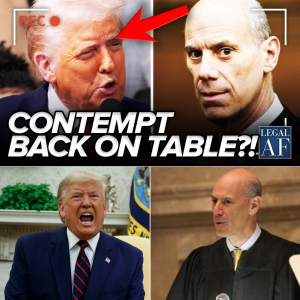A Fictional “SAT Card Reveal” Involving Donald Trump Goes Viral, Highlighting the Power of Political Fan Fiction in the Digital Age
A dramatic
 headline seized the attention of millions across social media this week:
headline seized the attention of millions across social media this week:“Trump ERUPTS After Jimmy Kimmel UNEARTHS His ‘REAL’ SAT CARD LIVE ON AIR — The Brutal On-Air Takedown That Left Mar-a-Lago in TOTAL CHAOS.”
Despite its explosive language and the suggestion of a televised revelation, no such segment ever aired. The claim is entirely fictional. But its rapid spread underscores how political storytelling — even when completely invented — increasingly shapes the digital information landscape and public imagination.
The headline blends several familiar elements of modern political entertainment: a late-night comedian as antagonist, a former president as the target and a dramatic, document-based “reveal” suggesting hidden truths. These ingredients have fueled viral narratives for years, particularly those built around Donald J. Trump, who remains one of the most polarizing figures in American politics.
A Fiction Presented With the Aesthetics of News
Across TikTok, Instagram Reels and X, the story circulated in posts designed to mimic breaking news. Some featured red alert banners, bold uppercase lettering and AI-generated voiceovers resembling television anchors. Others used edited clips of Kimmel speaking on unrelated topics, paired with captions implying he had exposed Trump’s academic records.
Media analysts say this blending of styles is now commonplace.
“The visual grammar of news is easily copied,” said Dr. Helena Mercer, a professor of digital media at Northwestern University. “When content looks urgent and authoritative, viewers instinctively treat it as at least partially credible — long enough for it to spread.”
There is no evidence that Kimmel has ever presented SAT-related documents about Trump on-air. Likewise, there is no record of Trump responding publicly to any such material.
Why the Story Found an Audience
Although fictional, the narrative felt familiar to many viewers because it aligned with long-standing public debates. Trump’s academic history has been a recurring topic in political and media circles for years, sometimes resurfacing in serious reporting and sometimes in satire.
“People weren’t responding to facts — they were responding to a storyline,” said Dr. Mercer. “Kimmel as the exposer, Trump as the reactor. It mirrors cultural roles that the audience already recognizes.”
This phenomenon is known as narrative plausibility: the tendency for audiences to accept or spread information that fits emotionally with their expectations, regardless of evidence.
Late-Night TV and Political Perception
The fictional scenario also reflects the increasingly political nature of late-night television. Over the last decade, hosts like Jimmy Kimmel, Stephen Colbert and Seth Meyers have incorporated pointed political commentary into their monologues, often targeted at Trump.
Clips from these segments circulate widely online, frequently stripped of context. As a result, satire, criticism and actual news become entangled in the public consciousness.
“Late-night shows now function as political commentary hubs,” said Dr. Marcus Hale, a communications analyst at Columbia University. “This makes them fertile ground for misinterpretation. Fictional ‘reveals’ can feel interchangeable with genuine monologues.”
The idea of Kimmel unveiling a “SAT card” thus fits neatly into the mental framework many viewers already hold.
Algorithmic Amplification of Political Fiction
:max_bytes(150000):strip_icc()/donald-trump-jimmy-kimmel-031824-344c3ea21e474793bf807b0254e39e4a.jpg)
The viral surge of the “SAT card” story also reflects how social platforms reward emotionally charged content. Posts promising humiliation, confrontation or scandal reliably receive high engagement, pushing them further into public view.
The headline used several key emotionally activating terms: ERUPTS, UNEARTHS, REAL, TAKEDOWN, TOTAL CHAOS.
Each is calibrated to trigger reactions — whether outrage, amusement or curiosity.
“In the attention economy, fiction optimized for emotional impact often outperforms fact,” Dr. Hale explained. “The SAT card story is a perfect example.”
Impact on Public Understanding
While many users recognized the story as satire or exaggeration, others responded as though it were factual. This mix of interpretations highlights a longstanding challenge: distinguishing political entertainment from political information, especially when both circulate in nearly identical visual formats.
Even fictional content can influence public attitudes. Researchers call this affective carryover — the tendency for emotional reactions to imaginary scenarios to shape real-world opinions.
“A viewer may know the SAT story isn’t true,” Dr. Mercer said, “but still incorporate its emotional implications into their perception of Trump.”
A Reflection of Broader Trends
The success of the fictional narrative reveals deeper truths about contemporary American political culture. Conflicts between politicians and entertainers have become standard drama in the national imagination. The merging of satire, parody and commentary allows fictional conflicts to feel as relevant as real ones.
In this environment, audiences often navigate a blend of fact, speculation and entertainment — making it increasingly difficult to maintain clear distinctions.
Conclusion
No SAT card was revealed on live television. Jimmy Kimmel made no such disclosure, and there was no chaos at Mar-a-Lago tied to any broadcast.
But the viral spread of the fictional headline shows how political fan fiction continues to shape online conversation — sometimes more powerfully than verified reporting.
As politics becomes ever more entwined with entertainment, the challenge is not merely identifying what is real, but understanding why fiction resonates so deeply.






